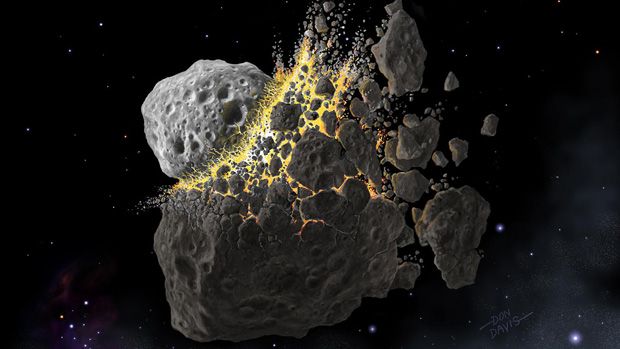Dust from a Giant Asteroid Collision Caused Ordovician Ice Age According to New Study
Global Climate Change in the Ordovician Caused by Dust from a Giant Asteroid
Scientists have been aware for some time that during the Middle Ordovician, our planet endured a prolonged but gradual period of global cooling. The average temperature on Earth fell and this opened up new ecological niches that permitted those animals and other organisms around at the time to adapt and to become more specious.
The cause of this world-wide ice age, one that started around 466 million years ago, is a mystery, but a team of scientists writing in the journal “Science Advances” think that they may have found the answer. They postulate that the global cooling was triggered by huge amounts of dust deposited in the atmosphere from an extraterrestrial asteroid collision.
An Enormous Impact in Outer Space

Picture credit: Don Davis, Southwest Research Institute
Dust from Outer Space
The Earth’s atmosphere is constantly bombarded by extraterrestrial space dust, but normally it only makes up a tiny proportion of all the dust in the atmosphere. Most of these tiny particles come from other sources such as volcanoes, forest fires, fine sand grains from deserts, pollution or from sea salt. However, the research team, which included scientists from the University of Chicago and Sweden’s Lund University postulate that the break-up of a 93-mile-wide asteroid in the asteroid belt between Mars and Jupiter led to the deposition of much more than just the normal background dosage of space dust.
Large amounts of dust would have interrupted the filtering of solar radiation to the surface of our planet and led to a period of dramatic global cooling.
Philipp Heck (University of Chicago), one of the co-authors of the paper published in “Science Advances” explained:
“Normally, Earth gains about 40,000 tons of extraterrestrial material every year. Imagine multiplying that by a factor of a thousand or ten thousand. Our hypothesis is that the large amounts of extraterrestrial dust over a timeframe of at least two million years played an important role in changing the climate on Earth, contributing to cooling.”
Giant Asteroid has Global Impact
If large amounts of ice were formed due to this cooling effect, then sea-levels would have fallen as evidenced by the geological record of strata that was formed during this time in Earth’s turbulent history. Falling sea levels would have changed ecosystems, potentially opening up new environments for organisms to exploit.
Lead author of the research paper, Birger Schmitz of Sweden’s Lund University added:
“Our results show for the first time that such dust, at times, has cooled Earth dramatically. Our studies can give a more detailed, empirical-based understanding of how this works, and this in turn can be used to evaluate if model simulations are realistic.”
Searching for the Evidence
The researchers analysed Ordovician rocks looking for rare Earth particles that could be associated with cosmic dust. Tiny micrometeorites collected from Antarctica were used to provide a base level of normal cosmic deposition. Evidence of rare helium isotopes along with other rare Earth metals confirmed that dust deposits were extraterrestrial in nature.
The Middle Ordovician cooling period could therefore have been caused by this excessive dust. The amount of water in the Earth’s oceans influences the way that rocks on the seabed form, and the rocks from this time period show signs of shallower oceans, an indication that some of the Earth’s water was trapped in glaciers and sea ice. Schmitz and his colleagues are the first to show that this ice age correlates with the extra dust in the atmosphere.
A Fragment of a Meteorite Preserved in Ordovician-aged Rock (Note the Orthocone Fossil)

Picture credit: John Weinstein/Chicago Field Museum
Gradual Climate Change Could Have Benefitted Life on Earth
Whilst the authors note that sudden and dramatic climate change can be very detrimental to ecosystems, the Middle Ordovician cooling could have proved to have been extremely beneficial.
Associate Professor Heck argues:
“In the global cooling we studied, we’re talking about timescales of millions of years. It’s very different from the climate change caused by the meteorite 65 million years ago that killed the dinosaurs, and it’s different from the global warming today—this global cooling was a gentle nudge. There was less stress.”
Rocks from Southern Sweden Record the Dramatic Increase in Cosmic Dust

Picture credit: Philipp Heck (University of Chicago)
Everything Dinosaur acknowledges the assistance of a press release from the University of Chicago in the compilation of this article.
Visit the Everything Dinosaur website: Everything Dinosaur.

